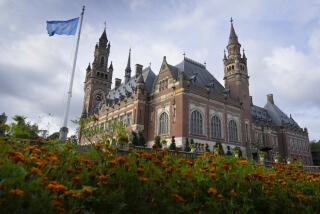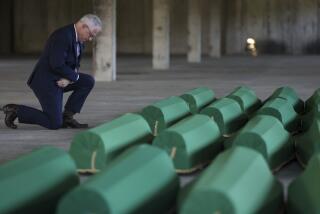Serbs sentenced in 1995 murders
- Share via
ROME — Serbs condemned Serbs in a Belgrade courtroom Tuesday, sending to prison four men from a paramilitary unit known as the Scorpions who were videotaped executing unarmed Bosnian Muslim youths as part of the 1995 Srebrenica massacre.
It was the first time a Serbian court confronted the events in Srebrenica, where nearly 8,000 Muslim men and boys were slaughtered in Europe’s deadliest atrocity since World War II.
Serbia’s war crimes court sentenced the four paramilitary fighters to prison terms ranging from five to 20 years for the murder of six Bosnian males, one just 16, in July 1995. In the videotape, which surfaced two years ago, the uniformed men can be seen smoking cigarettes and taunting the Bosnians, some bound and barefoot, as the fighters loaded captives into a truck, then later lined them up in a ditch and shot them in the back.
The court’s action was a significant step in Serbia’s flawed and tortuous attempts to come to terms with its long-denied role in the war in Bosnia-Herzegovina, a conflict that raged in the first half of the 1990s and helped tear apart the former Yugoslav federation.
But the judicial proceeding also fell egregiously short, several human rights activists said, because it did not hold Serbian military and political leaders accountable for the systematic killings, rapes and expulsions that emptied Srebrenica of its population in the final months of the war.
The town in eastern Bosnia was officially a U.N.-protected enclave when it was overrun by Serb forces under the command of Gen. Ratko Mladic, who was later charged in The Hague with war crimes, including genocide, and who remains at large.
The trial “showed, yes, there were crimes, but by individuals and not institutions,” complained Sonja Biserko, head of the Helsinki Committee for Human Rights in Serbia.
In the court case, “these crimes were not linked to Belgrade, to the army here ... to the state institutions who were involved in the planning,” she said in a telephone interview from the Serbian capital. “The verdict fits into the strategy of Belgrade ... to deflect blame.”
Establishing Belgrade’s responsibility for war crimes in Bosnia has long been a point of heated friction.
Ruling on a claim filed a decade ago by Bosnia, the United Nations’ highest court, the International Court of Justice, said in February that Belgrade failed to stop genocide in Srebrenica but was not responsible for it. The decision was controversial, and human rights attorneys say it appears the court did not have access to all of the evidence, including key and potentially incriminating records from the Serbian army.
Tuesday’s ruling similarly left a trail of disappointment.
Relatives of Srebrenica victims, many of them women from rural Bosnia who braved a hostile environment in Belgrade to attend the trial, were angry at what they regarded as light sentences.
“There is no justice at all in Serbia,” Nura Alispahic said between tears. Alispahic’s son Azmir, who is seen in the video, was the slain 16-year-old. She spoke Tuesday evening by phone from her home in the Bosnian city of Tuzla, which became a refuge for tens of thousands of survivors.
Natasa Kandic, whose Serbia-based human rights organization obtained the video and provided it to the international war crimes tribunal at The Hague during the trial of former Yugoslav President Slobodan Milosevic, also criticized Tuesday’s decision.
“Considering the gravity of the crime, the ruling did not deliver justice ... for victims who were killed only because they were Bosnians from Srebrenica,” she told reporters.
Until the video surfaced, many Serbs were in denial about widespread atrocities blamed on Serbian and Bosnian Serb forces fighting to put down rebellion by predominantly Muslim Bosnia, then part of Yugoslavia.
Four of the clearly terrified young men in the video were shot in the back. The Alispahic boy and a sixth youth were ordered to move the bodies to a barn, where they too were killed. Although the slayings occurred about 90 miles from Srebrenica, the victims had fled the town as Serb forces entered and apparently had been captured in the forest. Their bodies were later found in one of Bosnia’s many mass graves and identified through DNA.
The images in the tape, broadcast repeatedly on national Serbian television, shocked many and forced a new debate. Perhaps as a consequence, Tuesday’s verdicts did not trigger the kind of nationalistic furor that often accompanies criticism of Serbian wartime policies.
The case was seen as a test of the Serbian judiciary’s ability to prosecute and punish war crimes. The court faces enormous hurdles and has chalked up a spotty record in its three years of functioning.
“The fact that Serbs are trying Serbs in a national court is a huge step,” said Sara Darehshori, senior counsel for the International Justice Program of New York-based Human Rights Watch. “Especially given the difficult political situation.”
*
Special correspondent Zoran Cirjakovic in Bosnia contributed to this report.
More to Read
Sign up for Essential California
The most important California stories and recommendations in your inbox every morning.
You may occasionally receive promotional content from the Los Angeles Times.














